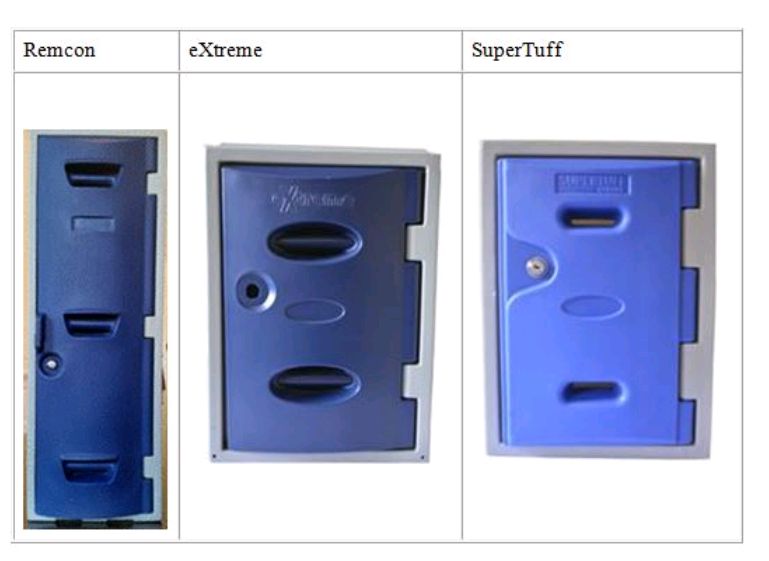
Judge Hacon's decision in a fairly classic unregistered design right case has offered some interesting commentary on the law relating to unregistered design rights and how parties should go about litigating them.
Background
The Claimant, Action Storage Systems Ltd ("Action") brought proceedings in the Intellectual Property Enterprise Court (the "IPEC") against two Defendants, G-Force Europe.com Ltd and Fletcher European Containers Ltd ("G-Force"), both under the control of the same single sole director. Action alleged that G-Force's 'SuperTuff' plastic lockers infringed UK unregistered design right in their own 'eXtreme' locker design.
Action had been manufacturing their eXtreme lockers since 2006. In around 2013, G-force began manufacturing the SuperTuff lockers to a very similar design. G-Force raised a number of issues in their defence, including the claim that the eXtreme lockers lacked novelty due to their similarities to earlier 'Remcon' designs. The Judge included images of all three designs in an annex to his judgment, the images of the front of the lockers can be seen above:
Originality
The Judge accepted that the Claimant's design was inspired by the Remcon design. This became clear in evidence and was not meaningfully disputed by the Claimants. The Judge found that, despite the clear influence of the Remcon design on the 'eXtreme' design, the latter was nonetheless original, save in relation to the moulded hinges and the Claimant had already accepted at the start of the trial that the hinges lacked originality.
An interesting exposition of the legal test for originality in design cases is a feature of the judgment. The traditional test mirrored that for determining originality in copyright cases. The question arose as to whether the old test – that the author had expended sufficient time, labour and skill – should be replaced by the new test for copyright as set out by the CJEU – that the work should be the author's own intellectual creation. The Judge had previously considered the test unchanged for UK unregistered designs but noted that Mr Justice Arnold had since taken a different view in another case. Since it was not pertinent to the matter in hand, the question remains unresolved, at least as far as Judge Hacon is concerned.
As a linked argument, the Defendants claimed that the eXtreme design was commonplace. The judge was critical of the Defendant's arguments on this point, finding that they lacked relevant prior art for each such feature at the relevant time. The Defendants relied upon the Remcon designs to argue that the eXtreme designs were commonplace but neither they nor their expert witness were able to demonstrate why the Remcon designs should be considered commonplace and accordingly why the eXtreme lockers should also be deemed so. The Judge found that these arguments also failed.
Features of 'shape and configuration'
The Defendants tried to introduce an argument that pleaded features of the eXtreme design were not features of shape and configuration. This argument was partly fuelled by the use of words such as 'approximate' and 'general' to define features of the eXtreme design in the Claimant's pleadings. The defence argued that this meant the claims extended beyond the precise dimensions of the eXtreme lockers and included alternative designs existing only in the abstract.
This led to a discussion of the revision to the statutory design right provisions in section 213(2) of the Copyright Designs and Patents Act 1988 (the "Act"), which were amended in October 2014 as follows:
"(2) in this Part 'design' means the design of
any aspect of the shape or configuration (whether internal
or external) of the whole or part of an article"
The Judge held that the amendment, though unclear in purpose, would have the effect of rendering abstract designs unprotected by UK unregistered design right but he found that it did not matter in the present case because he was satisfied by the Claimant's reassurance that they sought only to protect the precise features of the eXtreme locker design. The argument the pleaded features did not amount to features of shape and configuration therefore failed.
Method or principle of construction and must fit pleading
A final effort on the part of the Defence was demonstrated in its arguments that elements of the pleaded eXtreme locker design were governed by a method or principle or construction and/or a need to look the way they did to enable them to fit together (the lockers are designed to be stacked one atop another). In either case such elements would be ineligible for UK unregistered design protection.
Judge Hacon found that, whilst the designs, and features of them, were undoubtedly functional, no elements of the pleaded design were dictated by the method of manufacture or construction. The judge did find in the Defendants' favour on one point, accepting that the top and bottom panels of the eXtreme lockers were designed as they were to enable them to better fit together. This made no difference to the majority of the pleaded aspects of the design however nor the finding that UK unregistered design right subsisted in the design as a whole.
Primary and Secondary Infringement
The Claimant argued that the Defendants' actions amounted to both primary and secondary infringement. The Judge agreed, finding that the design of the eXtreme lockers was infringed by the identical proportions and dimensions of the SuperTuff lockers; the oval indentation on the front of the SuperTuff lockers; the shape of the sides of the SuperTuff lockers and the shapes of the rear of the SuperTuff lockers.
Production of the SuperTuff design by the Defendants was primary infringement as it was effectively 'making articles to that [the eXtreme] design' contrary to section 226 of the Act.
By having the SuperTuff lockers in their possession and offering them for sale, the Defendants were also committing acts of secondary infringement, contrary to section 227 of the Act. An element of notice to the Defendants is required for secondary infringement to be found. Judge Hacon held notice was fully given some 21 days after the Claimant's letter before claim was served on the Defendants, at which point they were aware of all the relevant facts and so became liable for secondary infringement.
Tables for future pleadings
Judge Hacon concluded his judgment with a useful recommendation for parties engaging in unregistered design right litigation in the future. Claimants should be encouraged to set out the significant features of a design or designs as they see them and the extent to which they are to be found in the defendant's accused article. Defendants may wish to respond in kind. Ideally such information should be set out in a table or chart, taking a form appropriate to the circumstances of the case. Where this approach is adopted, Judge Hacon believes it will greatly benefit the smooth running of the case.
Case – [2016] EWHC 3151
The content of this article is intended to provide a general guide to the subject matter. Specialist advice should be sought about your specific circumstances.

